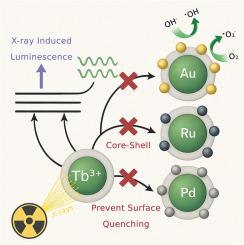Ru, Pd和Au修饰的掺铽LaPO4纳米粒子的x射线诱导发光和催化放射敏化
IF 5.7
3区 材料科学
Q2 MATERIALS SCIENCE, MULTIDISCIPLINARY
引用次数: 0
摘要
本研究探索了掺杂铽并以钌(Ru)、钯(Pd)和金(Au)作为潜在的放射增敏剂修饰的LaPO4纳米颗粒的合成、表征和辐射发光响应的优化。采用共沉淀法合成纳米颗粒,并通过沉积-沉淀-化学还原对其进行修饰。表面改性极大地影响了发光猝灭和催化性能。由于表面迁移,修饰纳米颗粒的辐射发光响应显示出明显的猝灭,而使用亚甲基蓝的测试证实了辐射催化响应的增强,特别是金修饰。此外,使用核壳纳米结构可以潜在地减少能量向表面的迁移,防止表面淬火。细胞毒性试验表明毒性很小,在某些情况下,观察到细胞生长刺激,强调了这些纳米材料在癌症治疗中的治疗应用潜力。本文章由计算机程序翻译,如有差异,请以英文原文为准。

X-Ray induced luminescence and catalytic radiosensitization of terbium-doped LaPO4 nanoparticles decorated with Ru, Pd, and Au
This work explores the synthesis, characterization, and optimization of the radioluminescent response of LaPO4 nanoparticles doped with terbium and decorated with ruthenium (Ru), palladium (Pd), and gold (Au) as potential radiosensitizers. The nanoparticles were synthesized via a co-precipitation method and modified through deposition-precipitation followed by chemical reduction. Surface modification drastically influenced luminescence quenching and catalytic performance. The radioluminescent response of the decorated nanoparticles showed notable quenching due to surface migration, whereas tests using methylene blue confirmed an enhancement in the radiocatalytic response, particularly with Au decoration. Moreover, using core-shell nanostructures was observed to potentially decrease energy migration to the surface, preventing surface quenching. Cytotoxicity assays indicated minimal toxicity, and in some cases, cell growth stimulation was observed, underscoring the potential of these nanomaterials for theragnostic applications in cancer treatment.
求助全文
通过发布文献求助,成功后即可免费获取论文全文。
去求助
来源期刊

Materials Research Bulletin
工程技术-材料科学:综合
CiteScore
9.80
自引率
5.60%
发文量
372
审稿时长
42 days
期刊介绍:
Materials Research Bulletin is an international journal reporting high-impact research on processing-structure-property relationships in functional materials and nanomaterials with interesting electronic, magnetic, optical, thermal, mechanical or catalytic properties. Papers purely on thermodynamics or theoretical calculations (e.g., density functional theory) do not fall within the scope of the journal unless they also demonstrate a clear link to physical properties. Topics covered include functional materials (e.g., dielectrics, pyroelectrics, piezoelectrics, ferroelectrics, relaxors, thermoelectrics, etc.); electrochemistry and solid-state ionics (e.g., photovoltaics, batteries, sensors, and fuel cells); nanomaterials, graphene, and nanocomposites; luminescence and photocatalysis; crystal-structure and defect-structure analysis; novel electronics; non-crystalline solids; flexible electronics; protein-material interactions; and polymeric ion-exchange membranes.
 求助内容:
求助内容: 应助结果提醒方式:
应助结果提醒方式:


